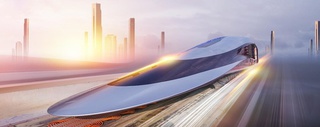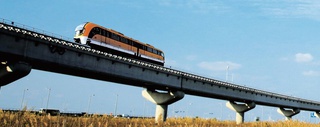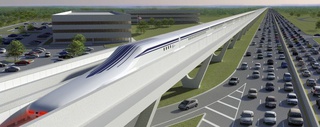The New Generation CRRC Maglev 3.0
The next-generation Chinese medium-low speed maglev doubles the first generation's top speed, and it becomes driverless. This new version of the CRRC maglev trains will elevate the intercity transit in China – and possibly abroad. Most of the R&D work is done in Hunan Province, which received a new nickname: "Magnetic Capital of China".
CRRC Maglev 1.0 - 2015
The first versions of the low-medium speed CRRC maglevs are used on the Changsha Maglev (2016) and the Beijing S1 lines (2017). The Changsha rolling stock tops out at 120 km/h (75 mph) if pushed hard, while the Beijing train (CRRC Tangshan) is limited to 105 km/h (65 mph). However, the commercial top speed on both maglev lines is capped at 100 km/h (62 mph) for safety reasons. This generation has a proven safety record of over 2 million accident-free km's and close to 10 million passengers.

CRRC Maglev 2.0 - 2018
The next generation of the low-medium Chinese maglev train is capable of a top speed of 160 km/h (99 mph). This train has been undergoing thorough testing at the Changsha Maglev Express line. In this new iteration, the traction efficiency was improved by 30 percent, and it has an increased suspension capacity of 6 tonnes.

CRRC Maglev 3.0 - 2020
The CRRC Maglev 3.0 train is designed to run at 200 km/h (124 mph). That's double the speed of the first generation trains. They are built and developed in China by CRRC Zhuzhou Locomotives Co. Ltd., a subsidiary of China Railway Rolling Stock Corporation, one of the world's largest train manufacturers.
This new generation will fill a gap in this speed class in transportation. Unlike traditional rail, the medium-low speed maglev trains have rapid acceleration and very low noise. They emit as much noise at top speed as a vacuum cleaner – about 70 decibels. This makes them a strong contender for the future of intercity travel.
Compared to the previous versions, the improvements include replacing the contact power supply with non-contact technology. The short stator asynchronous motor is changed to a long stator synchronous motor. The traction inverter is moved from the bottom of the car body to the ground power station. Most importantly, however, it's the first driverless version of this medium-low-speed maglev. The new generation has 50% better acceleration and improved climbing abilities on the performance front. It's capable of ascending heights up to four stories in just 100 meters. In addition, the upgraded computers improve safety with quicker calculations. The "brain", as CRRC refers to it, can diagnose faults in vehicles, tracks, and power supply in real-time.





